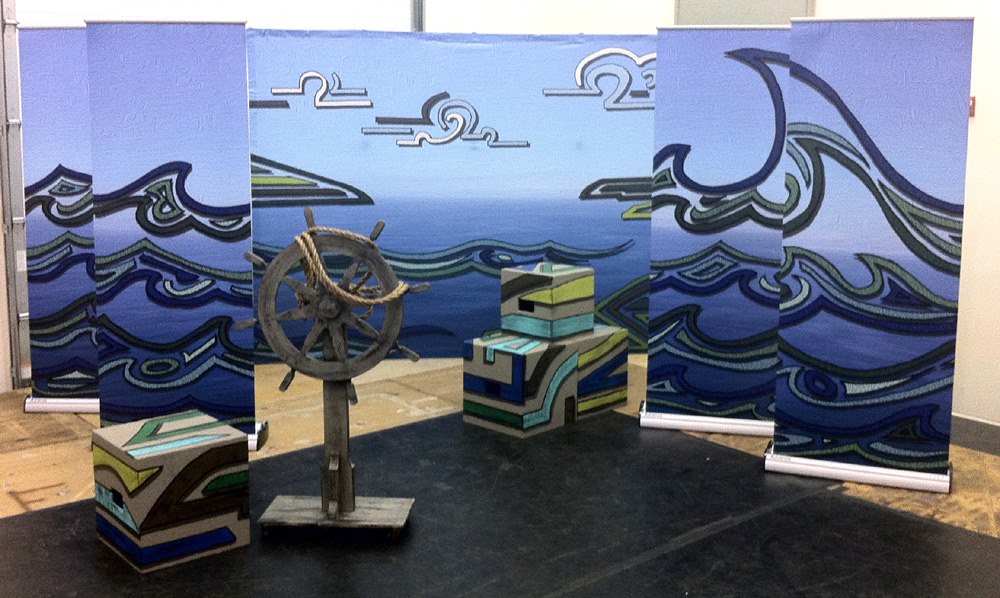
A picture of the set, taken from Seattle Opera’s FB page because of technical difficulties related to my cell phone.
At the end of my rant about holding on to my own aesthetic standards in the face of a sanitized kid-friendly worldview, I gave opera as an example of music that really didn’t work for kids. I ate my words at Seattle Opera’s performance of La Cenerentola, a Cinderella story that both of my daughters would have enjoyed completely. About the same time, I won a Twitter contest for tickets to see Heron and the Salmon Girl.
Generation Gap
My argument against kids’ music had been that parents deserve good art even while preoccupied with child care. Heron and the Salmon Girl opened a whole other dimension to the issue, reminding me that kids deserve good art, too. What’s more, but the world needs kids to know and love good art if good art is to survive. Introducing the performance, the announcer referred to the performers in the Seattle Youth Symphony as “another endangered species.”
I’ve commented before about what counts as “young” in the opera world. At my day job in county government, we are always talking about “succession planning,” because the average age of our workforce is close to the average age of retirement. Young people cannot love music they are not exposed to, and if they don’t love classical music, they will not learn to play it. Arguably the highest expression of Western culture, classical music could become endangered. It’s painfully obvious that art forms cannot survive if they are not passed down through generations, but part of the cost of our helicopter parenting culture is that the obvious is overlooked. We are so busy guarding our kids against things they’re not ready for that we forget to prepare them for anything.
Our Earth
Heron and the Salmon Girl is part of a program to bring the next generation into the classical fold. It results from a partnership Seattle Opera, Seattle Youth Symphony, and The Nature Conservancy formed to create a new opera, rooted in the environment and native cultures of the Pacific Northwest, and utilizing the talents and energy of young musicians in the region. The three parts of the Our Earth cycle are debuted separately over the course of the year, essentially creating a youth opera season. Performances are held throughout the region, and can even be arranged in individual schools. In February I attended the premier of the first part, Heron and the Salmon Girl, at Town Hall with my four year-old, Little A.
Wagner First
The performance began with the Seattle Youth Symphony performing two pieces by Wagner. I’m not a fan of Wagner, but I know that his music is considered technically challenging. The Seattle Youth Symphony Orchestra organization is one of the best in the country. (Their website says so, but I’m inclined to believe them. I’ve suffered through some painful high school orchestra performances, and this was nothing like them). Although their skill assuaged some of my newly-raised fears for the future of orchestra, the children in the audience reminded me this kind of music is as challenging to the listener as the artist. Little A opted to nap on my lap. Rare is the child who will be instantly captivated by this music. If you have one of them, get them an instrument and find a teacher immediately!
Adina Aaron, who has already built a reputation in the role of Aida, provided a visual focus. That helped settle some of the restless little ones – at least for a while. I’m not as familiar with Aida as I should be, but Aaron’s voice had the deep resonance that I tend to associate with mezzo-soprano roles like Carmen. Despite the gravitas of the music, Aaron was very emotive. It was delightful to be so close to the stage in a smaller venue. I could see more expression and body language than I usually get up in the cheap seats.
Heron and the Salmon Girl
After a much needed intermission – an hour is a long time for a four year-old to sit still and listen – we got to see the opera. It was truly an opera for kids. The natural and cultural histories behind the piece were explained before the music started. The audience learned a few key words in Lushootseed. That made me think how cool it be to see an entire opera in a native American language. The libretto this time was in English. The earnestness was a little too much at times. (How could it not be? It’s an opera in Seattle about the environment. Triple threat sincerity!) But there was a lot of humor, too, and the humor was pitch-perfect (sorry) for the audience. I would never have thought to characterize Orca as an overenthusiastic Rintoo type pest.
If you want a kid to eat a vegetable, have them grow it themselves. Occasionally, children appear in operas as extras, or as in La Bohéme, sing one line. Heron and the Salmon Girl includes a child chorus that sings as ocean waves, river currents, and salmon fry. When the wave chorus rolled down the aisles it really caught Little A’s attention! Kids in the audience really do connect best when kids are on the stage. And actually performing an opera is sure to give young performers a much stronger bond with the art form than anything else could.
{2018 Update: Since watching Heron and the Salmon Girl, I have seen children perform significant roles in other operas. Most notably, in Hansel and Gretel.}





About the author